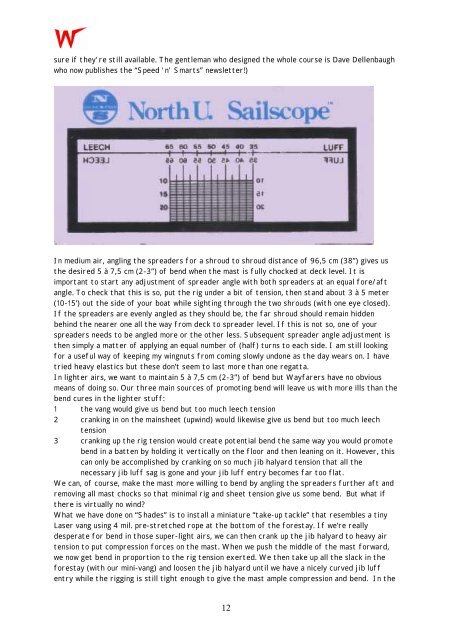File - Canadian Wayfarer Association
File - Canadian Wayfarer Association
File - Canadian Wayfarer Association
Create successful ePaper yourself
Turn your PDF publications into a flip-book with our unique Google optimized e-Paper software.
sure if they're still available. The gentleman who designed the whole course is Dave Dellenbaugh<br />
who now publishes the “Speed 'n' Smarts” newsletter!)<br />
In medium air, angling the spreaders for a shroud to shroud distance of 96,5 cm (38”) gives us<br />
the desired 5 à 7,5 cm (2-3”) of bend when the mast is fully chocked at deck level. It is<br />
important to start any adjustment of spreader angle with both spreaders at an equal fore/aft<br />
angle. To check that this is so, put the rig under a bit of tension, then stand about 3 à 5 meter<br />
(10-15’) out the side of your boat while sighting through the two shrouds (with one eye closed).<br />
If the spreaders are evenly angled as they should be, the far shroud should remain hidden<br />
behind the nearer one all the way from deck to spreader level. If this is not so, one of your<br />
spreaders needs to be angled more or the other less. Subsequent spreader angle adjustment is<br />
then simply a matter of applying an equal number of (half) turns to each side. I am still looking<br />
for a useful way of keeping my wingnuts from coming slowly undone as the day wears on. I have<br />
tried heavy elastics but these don’t seem to last more than one regatta.<br />
In lighter airs, we want to maintain 5 à 7,5 cm (2-3”) of bend but <strong>Wayfarer</strong>s have no obvious<br />
means of doing so. Our three main sources of promoting bend will leave us with more ills than the<br />
bend cures in the lighter stuff:<br />
1 the vang would give us bend but too much leech tension<br />
2 cranking in on the mainsheet (upwind) would likewise give us bend but too much leech<br />
tension<br />
3 cranking up the rig tension would create potential bend the same way you would promote<br />
bend in a batten by holding it vertically on the floor and then leaning on it. However, this<br />
can only be accomplished by cranking on so much jib halyard tension that all the<br />
necessary jib luff sag is gone and your jib luff entry becomes far too flat.<br />
We can, of course, make the mast more willing to bend by angling the spreaders further aft and<br />
removing all mast chocks so that minimal rig and sheet tension give us some bend. But what if<br />
there is virtually no wind?<br />
What we have done on “Shades” is to install a miniature “take-up tackle” that resembles a tiny<br />
Laser vang using 4 mil. pre-stretched rope at the bottom of the forestay. If we’re really<br />
desperate for bend in those super-light airs, we can then crank up the jib halyard to heavy air<br />
tension to put compression forces on the mast. When we push the middle of the mast forward,<br />
we now get bend in proportion to the rig tension exerted. We then take up all the slack in the<br />
forestay (with our mini-vang) and loosen the jib halyard until we have a nicely curved jib luff<br />
entry while the rigging is still tight enough to give the mast ample compression and bend. In the<br />
12


